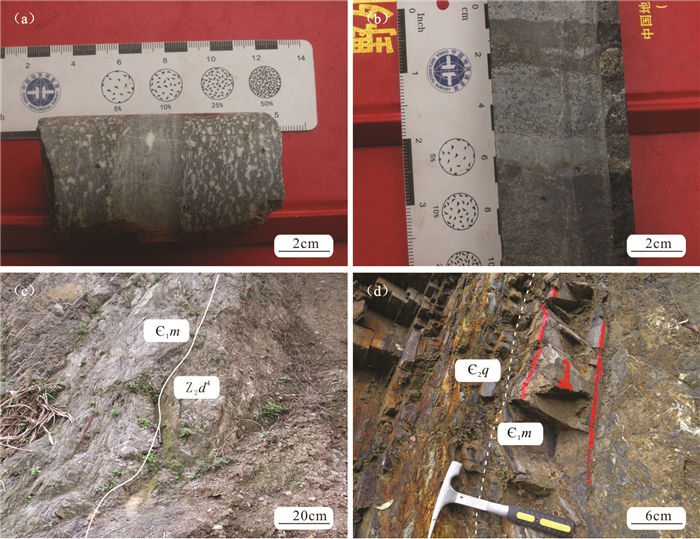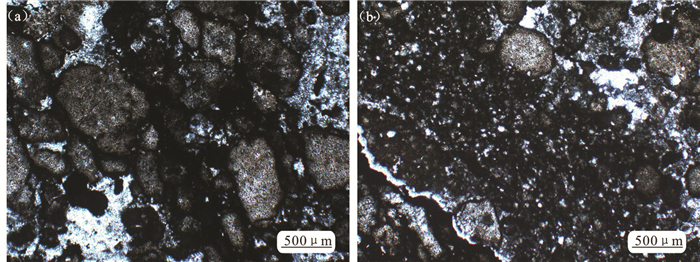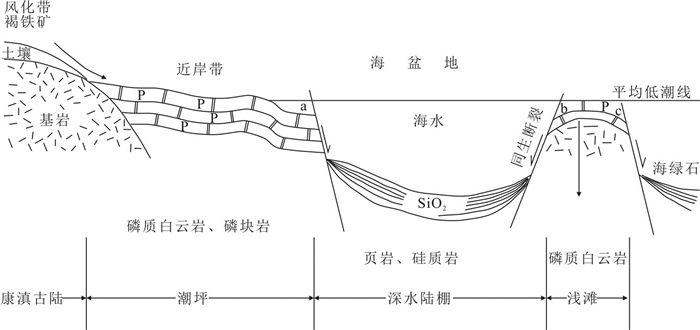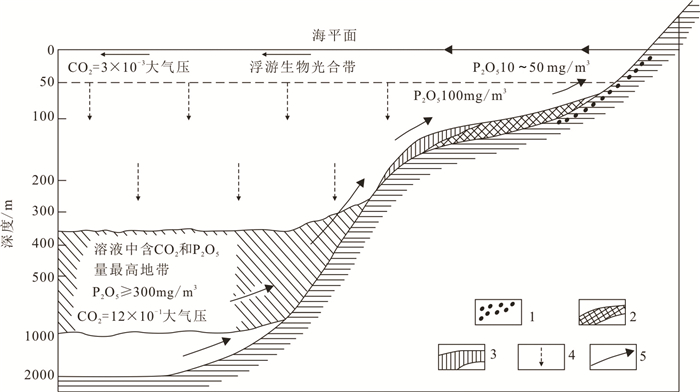Phosphorus-bearing strata in Maidiping Formation of the Lower Cambrian in Leibo area of Sichuan Province and its potential of phosphate resources
-
摘要:
研究目的 四川省雷波县至云南省永善县是寒武系麦地坪组磷矿聚集区,含磷地层的研究不仅有助于深入分析磷矿形成的古地理环境及其变化特征,而且结合构造背景的研究,可研究磷矿形成分布规律,为磷矿的开发提供理论依据。
研究方法 以岩心编录及剖面测量为基础,研究了雷波地区麦地坪组含磷层系厚度、岩性、沉积相、沉积模式、构造背景、盆地性质、磷矿成因机制、磷块岩岩石学特征及其变化等。
研究成果 阐明了雷波地区麦地坪组在50km范围内,岩性、岩相的巨大差异以及磷块岩特征,指出雷波地区在麦地坪组沉积时期呈隆、凹相间的格局,缺失浅水陆棚相。白云岩相区属潮坪相,是磷矿聚集的有利地段。硅质岩属深水陆棚相,是火山活动形成的热水作用成因。磷矿的聚集是硅质岩相区火山活动,生物发育,高温洋流由下向上运动,携带生物遗体分解的高P2O5浓度海水在凹陷区两侧白云岩相区沉积和改造的结果。从大地构造背景、盆地性质、磷质来源、磷的迁移、沉淀、富集阐述了磷矿成矿作用机制,提出雷波地区磷矿是多种因素作用形成,建立了相应的磷矿成矿模式。
结论 发现揭示了新元古代末期至寒武纪早期,裂谷盆地发育的晚期阶段,一种新的磷成矿作用——隆、凹相间的古地理格局及微弱的火山活动,在空间上有效配置,并由此提出在凹陷两侧白云岩相区寻找磷矿的预测评价新思路,指出针对麦地坪组磷矿找矿的新方向,在找矿空间可由凹陷区向四周拓展。
Abstract:This paper is the result of mineral exploration engineering.
Objective The phosphate deposit accumulation scope of Maidiping Formation of the Lower Cambrian covers a wide area from Leibo County (Sichuan) to Yongshan County (Yunnan). The study of phosphorus-bearing strata is not only helpful to the reconstruction of the paleogeographic environment and its varied characteristics, but also can obtain the formation and distribution of phosphate deposits in combination with the study of tectonic background, and provide a thedeposittical basis for the development of phosphate deposit.
Methods Based on the cdeposit record and section measurement, this paper studies the thickness, lithology, sedimentary facies, sedimentary model, tectonic background, basin properties, genetic mechanism of phosphate deposit, petrological features of phosphorite, and their changes in Maidiping Formation in Leibo area.
Results The significant difference of lithology and lithofacies of the Maidiping Formation in Leibo area are within 50 kilometers, and the characteristics of phosphorite are well explained. It is pointed out that the Leibo area was an uplift and depression environment during the sedimentary period of Maidiping Formation, and the shallow shelf facies was absent. Dolomite facies area belongs to tidal flat facies, which is a favorable area for the phosphate deposit accumulation. Siliceous rocks belong to deep-water shelf facies and are of hydrothermal origin formed by volcanic activity. The accumulation of phosphorite is the result of volcanic activity in siliceous lithofacies area, biological development, movement of high temperature ocean current from the bottom to the top, sedimentation of the seawater with high P2O5 carried by ocean current decomposing biological remains in dolomite facies area on both sides of the sag area and post-sedimentation transformation. Based on the tectonic background, basin nature, source of phosphorus, migration, sedimentation and enrichment of phosphorus, the deposit-forming mechanism of phosphate is described, and the formation of phosphate deposit in Leibo area is suggested by the interaction of many factors, and the corresponding deposit-forming model of phosphate deposit is established. The siliceous rocks in the depression are the result of the hot water activity under volcanism.
Conclusions The study revealed a new phosphorus mineralization style in the late stage of rift basin development from Late Neoproterozoic to Early Cambrian, i.e., the paleogeographic pattern of alternating uplift and depression with the weak volcanic activity. A new idea of predicting and evaluating the phosphate deposit in dolomite facies area on both sides of the depression is put forward. We suggest that the prospecting space of the Maidiping Formation phosphate deposit should be expanded from the depression area to the surrounding areas.
-

-
图 5 前人经典的磷矿成因模式(据冯增昭, 1982修改)
Figure 5.
-
Adachi M, Yamamota K, Suigisk R. 1986. Hydrohhermal chert and associated siliceous rocks from the northern Pacific: Their geological significance as indication of ocean ridge activity[J]. Sedimentary Geology, 47(1/2): 125-148.
Dalziel I W D. 1991. Neoproterozoic-Paleozoic geography and tectonics: Review, hypothesis, environmental speculation[J]. Geological Society of America Bulletin, 109(1): 16-42.
Deng Shenghui, Fan Ru, Li Xin, Zhang Shiben, Zhang Baomin, Lu Yuanzheng. 2015. Subdivision and correlation of the Sinian (Ediacaran) System in the Sichuan Basin and Adjacent area[J]. Journal of Stratigraphy, 39(4): 239-254(in Chinese with English abstract).
Edmond J M, Damm K V. 1983. Hot springs at the bottom of the ocean[J]. Science, (8): 37-50.
Feng Weiming, Xie Yuan, Li Rong, Luo Jianning, Lin Jiashan, Liu Jianqing, Zhao Zhan. 2017. Restoration of kast palaeotopography on the Tongwan Movement period in the southeastern Sichuan and northwestern Guizhou[J]. Geological Review, 63(5): 1270-1280(in Chinese with English abstract).
Feng Zengzhao. 1982. Sedimentary Petrology[M]. Beijing: Petroleum Industry Press, 48(in Chinese).
Ge Xiangying, Mou Chuanlong, Yu Qian, Liu Wei, Men Xin, He Jianglin, Lu Junze, Liang Wei. 2021. Petrology and geochemistry of K-bentonites at Ordovician-Silurian transition in XD2 well, Daguan, Yunnan Province[J]. Geology in China, 48(3): 911-924(in Chinese with English abstract).
Hao Jie, Zhai Mingguo. 2004. Jinning movement and Sinian system in China: Their relationship with Rodinia supercontinent[J]. Chinese Journal of Geology, 39(1): 139-152(in Chinese with English abstract).
Herzing P M. 1988. Hydrothermal silica chiminey field in the Galapagos Spreeding Center at 86w[J]. Earth and Planetary Science Letters, 89(1): 281-320.
Hoffman P F. 1991. Did the breakup of Laurentia turn Gondwana inside out?[J]. Science, 252: 1409-1412. doi: 10.1126/science.252.5011.1409
Hou Fanghao, Fang Shaoxian, Wang Xingzhi. 1999. Review on Sinian Dengying Formation reservoir and permeability in Sichun Basin[J]. Acta Petrolei Sinica, 20(6): 16-21(in Chinese with English abstract).
Hou Xuelin, Guo Guangyu. 1991. Tengchong-Lianghe geothermal system and modern hot spring gold mineralization in Yunnan[J]. Geological Review, 37(3): 241-249(in Chinese with English abstract).
Huang Jiqing, Ren Jishun, Jiang Chunfa. 1974. Some new observation on the geotectonic characteristics of China[J]. Acta Geologica Sinica, 48(1): 36-52(in Chinese with English abstract)
Li Wei, Liu Jingjiang, Deng Shenghui, Zhang Baomin, Zhou Hui. 2015. The nature and role of Late Sinian-Early Carbrian tectonic movement in Sichuan Basin and its adjacent areas[J]. Acta Petrolei Sinica, 36(5): 546-563(in Chinese with English abstract)
Liu Baojun, Xu Xiaosong, Pan Xingnan. 1993. The Sedimentary Evolution and Mineralization of Ancient Continent in South China[M]. Beijing: Science Press, 56-58(in Chinese).
Liu Jianqing, He Li, He Fei, He Jiawei, He Ping. 2021. Devonian stratigraphic sequence in Daguan area of Yunnan Province and its resource potentials of industrial quartz sand[J]. Geology in China, 48(3): 925-938(in Chinese with English abstract).
Liu Shugen, Liu Shu, Sun Wei, Song Jinmin, Ran Bo, Zhong Yong, Ye Yuehao, Jiang Nengchun, Xia Guodong. 2018. Tectonic and sedimentary features of northern Mianyang-Changning intracratonic sags, Sichuan, China[J]. Journal of Chengdu University of Technology(Science & Technology Edition), 45(1): 1-13(in Chinese with English abstract)
Liu Shugen, Sun Wei, Luo Zhili, Song Jinmin, Zhong Yong, Tian Yanhong, Pen Hanlin. 2013. Xingkai taphrogenesis and petroleum exploration from Upper Sinian to Cambrian strata in Sichuan Basin, China[J]. Journal of Chengdu University of Technology(Science & Technology Edition), 40(5): 511-520(in Chinese with English abstract)
Liu Shugen, Wang Yigang, Sun Wei, Zhong Yong, Hong Haitao, Deng Bin, Xia Maolong, Song Jinmin, Wei Yingchu, Wu Juan. 2016. Control of intracratonic sags on hydrocarbon accumulations in the marine strata across the Sichuan Basin, China[J]. Journal of Chengdu University of Technology (Science and Technology Edition), 43(1): 1-23(in Chinese with English abstract)
Moores E W. 1991. Southwest US-east Antarctica (SWEAT) connection: A hypothesis[J]. Geology, 19: 425-428.
Peng Jun, Tian Jingchun, Yi Haisheng, Xia Wenjie. 2000. The Late Precambrian hot water sedimentation of southeast Yangtze Plate continental margin[J]. Acta Sedimentologica Sinica, 18(1): 107-113(in Chinese with English abstract).
Peng Shanchi. 2009. New Cambrian biostratigraphic sequence and chronostratigraphic system in south China[J]. Chinese Science Bulletin, 54(18): 2691-2698(in Chinese). doi: 10.1360/csb2009-54-18-2691
Shi Chunhua. 2005. Formation of Phosphorite Deposits, Breakup of Rodinia Supercontinent and Biology Explosition-A Case Study of Weng'an, Kaiyang, Zhijin Phosphorite Deposits of Guizhou Province[D]. Guiyang: The Institute of Geochemistry, Chinese Academy of Science, 20-37(in Chinese with English abstract).
Song Tianrui. 2007. On the types of phosphate deposits in northern China and direction for ore finding[J]. Geology in China, 34(2): 315-323(in Chinese with English abstract).
Wang Jian, Li Xianhua, Duan Taizhong. 2003. New evidences on zircon SHRIMP dating for the Cangshuipu volcanic rocks and its implications for the basal boundary of "Nanhua" strata in south China[J]. Chinese Science Bulletin, 48(16): 1726-1731(in Chinese). doi: 10.1360/csb2003-48-16-1726
Wang Jian. 2005. New Advaances in the study of the "Nanhuaan System"-with particular reference to the stratigraphic division and correlation of the Nahuaan System, south China[J]. Geological Bulletin of China, 24(6): 491-495(in Chinese with English abstract).
Wang Zecheng, Jiang Hua, Wang Tongshan, Lu Weihua, Gu Zhidong, Xu Anna, Yang Yu, Xu Zhaohui. 2014. Palae-geomorphology formed Tongwan tectonization in Sichuan Basin and it's significance for hydrocarbon[J]. Petroleum Exploration and Development, 41(3): 305-312(in Chinese with English abstract).
Wei Guoqi, Yang Wei, Du Jinhu, Xu Chunchun, Zhou Caineng, Xie Wuren, Zeng Fuying, Wu Saijun. 2015. Geological characteristics of the Sinian-Early Cambrian intracratonic rift, Sichuan Basin[J]. Natural Gas Industry, 35(1): 24-35(in Chinese with English abstract).
Xia Guodong, Ran Bo, Sun Wei, Song Jinmin, Ye Yuehao, Jiang Lei, Zhao Cong, Lai Dong. 2018. Characteristics of hydrocarbon source rocks of the Lower Cambrian Maidiping Formation in northern Mianyang-Changning intracratonic sag, Sichuan, China[J]. Journal of Chengdu University of Technology(Science & Technology Edition), 45(1): 14-26(in Chinese with English abstract).
Yang Zhongfang, Chen Min, Yang Yuchuan. 2017. Characteristics and sedimentary environment of Xiaogou Phosphate layer in Leibo County[J]. Sichuan Nonferrous Metals, (3): 24-27(in Chinese with English abstract).
Zhang Jun, Zhang Yu, Yang Yuchuan. 2018. Sedimentary characteristics and mineralization of phosphorite deposits in Leibo ore field, Sichuan[J]. Sedimentary Geology and Tethyan Geology, 38(4): 76-84(in Chinese with English abstract).
Zhao Wenzhi, Wei Guoqi, Yang Wei, Mo Wuling, Xie Wuren, Su Nan, Liu Mancang, Zeng Fuying, Wu Saijun. 2017. Discovery of Wanyuan-Dazhou intracratonic rift and its exploration significance in the Sichuan Basin, SW China[J]. Petroleum Exploration and Development, 44(5): 659-669(in Chinese with English abstract).
Zhou Guoxiao, Wei Guoqi, Hu Guoyi, Wu Saijun, Tian Yajie, Dong Caiyuan. 2020. The development setting and organic matter of the Lower Cambrian shales from the western rift trough in Sichuan Basin[J]. Natural Gas Geoscience, 31(4): 498-506(in Chinese with English abstract).
邓胜徽, 樊茹, 李鑫, 张师本, 张宝民, 卢远征. 2015. 四川盆地及周缘震旦系(埃迪卡拉)系划分与对比[J]. 地层学杂志, 39(4): 239-254. https://www.cnki.com.cn/Article/CJFDTOTAL-DCXZ201503001.htm
冯伟明, 谢渊, 李嵘, 罗建宁, 林家善, 刘建清, 赵瞻. 2017. 川东南-黔西北桐湾Ⅲ幕岩溶古地貌恢复[J]. 地质论评, 63(5): 1270-1280. https://www.cnki.com.cn/Article/CJFDTOTAL-DZLP201705011.htm
冯增昭. 1982. 沉积岩石学[M]. 北京: 石油工业出版社, 48.
葛祥英, 牟传龙, 余谦, 刘伟, 门欣, 何江林, 陆俊泽, 梁薇. 2021. 云南大关新地2井奥陶-志留纪之交钾质斑脱岩岩石地球化学特征分析[J]. 中国地质, 48(3): 911-924. http://geochina.cgs.gov.cn/geochina/article/abstract/20210318?st=search
郝杰, 翟明国. 2004. 罗迪尼亚超大陆与晋宁运动和震旦系[J]. 地质科学, 39(1): 139-152. https://www.cnki.com.cn/Article/CJFDTOTAL-DZKX200401015.htm
侯方浩, 方少仙, 王兴志. 1999. 四川震旦系灯影组天然气藏储渗体的再认识[J]. 石油学报, 20(6): 16-21. https://www.cnki.com.cn/Article/CJFDTOTAL-SYXB199906002.htm
侯学林, 郭光裕. 1991. 云南腾冲-梁河地热系统与现代热泉型金矿化作用[J]. 地质论评, 37(3): 241-249. https://www.cnki.com.cn/Article/CJFDTOTAL-DZLP199103005.htm
黄汲清, 任纪舜, 姜春发. 1974. 对中国大地构造若干特点的新认识[J]. 地质学报, 48(1): 36-52. https://www.cnki.com.cn/Article/CJFDTOTAL-DZXE197401003.htm
李伟, 刘静江, 邓胜徽, 张宝民, 周惠. 2015. 四川盆地及邻区震旦纪末-寒武纪早期构造运动性质与作用[J]. 石油学报, 36(5): 546-563. https://www.cnki.com.cn/Article/CJFDTOTAL-SYXB201505003.htm
刘宝珺, 许效松, 潘杏南. 1993. 中国南方古大陆沉积地壳演化与成矿[M]. 北京: 科学出版社, 56-58.
刘建清, 何利, 贺飞, 何佳伟, 何平. 2021. 云南大关地区泥盆系地层序列及其工业砂资源潜力分析[J]. 中国地质, 48(3): 925-938. http://geochina.cgs.gov.cn/geochina/article/abstract/20210319?st=article_issue
刘树根, 刘殊, 孙玮, 宋金民, 冉波, 钟勇, 叶玥豪, 蒋能春, 夏国栋. 2018. 绵阳-长宁拉张槽北段构造-沉积特征[J]. 成都理工大学学报(自然科学版), 45(1): 1-13. https://www.cnki.com.cn/Article/CJFDTOTAL-CDLG201801001.htm
刘树根, 孙玮, 罗志立, 宋金民, 钟勇, 田艳红, 彭瀚霖. 2013. 兴凯地裂运动与四川盆地下组合油气勘探[J]. 成都理工大学学报(自然科学版), 40(5): 511-520. https://www.cnki.com.cn/Article/CJFDTOTAL-CDLG201305003.htm
刘树根, 王一刚, 孙玮, 钟勇, 洪海涛, 邓宾, 夏茂龙, 宋金民, 文应初, 吴娟. 2016. 拉张槽对四川盆地海相油气分布的控制作用[J]. 成都理工大学学报(自然科学版), 43(1): 1-23. https://www.cnki.com.cn/Article/CJFDTOTAL-CDLG201601001.htm
彭军, 田景春, 伊海生, 夏文杰. 2000. 扬子板块东南大陆边缘晚前寒武纪热水沉积作用[J]. 沉积学报, 18(1): 107-113. https://www.cnki.com.cn/Article/CJFDTOTAL-CJXB200001017.htm
彭善池. 2009. 华南新的寒武纪生物地层序列和年代地层系统[J]. 科学通报, 54(18): 2691-2698. https://www.cnki.com.cn/Article/CJFDTOTAL-KXTB200918010.htm
施春华. 2005. 磷矿的形成与Rodinia超大陆裂解、生物爆发的关系——以贵州瓮安、开阳、织金磷矿为例[D]. 贵阳: 中国科学院地球化学研究所, 20-37.
宋天锐. 2007. 中国北方磷矿成矿类型和找矿方向[J]. 中国地质, 34(2): 315-323. http://geochina.cgs.gov.cn/geochina/article/abstract/20070214?st=search
王剑, 李献华, Duan T Z. 2003. 沧水铺组火山岩锆石SHRIMP年龄及南华系底界新证据[J]. 科学通报, 48(16): 1726-1731. https://www.cnki.com.cn/Article/CJFDTOTAL-KXTB200316002.htm
王剑. 2005. 华南"南华系"研究新进展——论南华系地层划分与对比[J]. 地质通报, 24(6): 491-495. https://www.cnki.com.cn/Article/CJFDTOTAL-ZQYD200506001.htm
汪泽成, 姜华, 王铜山, 鲁卫华, 谷志东, 徐安娜, 杨雨, 徐兆辉. 2014. 四川盆地桐湾期古地貌特征及成藏意义[J]. 石油勘探与开发, 41(3): 305-312. https://www.cnki.com.cn/Article/CJFDTOTAL-SKYK201403008.htm
魏国齐, 杨威, 杜金虎, 徐春春, 皱才能, 谢武仁, 增富英, 武赛军. 2015. 四川盆地震旦纪-早寒武世克拉通内裂陷地质特征[J]. 天然气工业, 35(1): 24-35. https://www.cnki.com.cn/Article/CJFDTOTAL-TRQG201501004.htm
夏国栋, 冉波, 刘树根, 孙玮, 宋金民, 叶玥豪, 姜磊, 赵聪, 赖冬. 2018. 绵阳-长宁拉张槽北段麦地坪组烃源岩特征——以绵竹清平剖面为例[J]. 成都理工大学学报(自然科学版), 45(1): 14-26. https://www.cnki.com.cn/Article/CJFDTOTAL-CDLG201801002.htm
杨忠芳, 陈敏, 杨豫川. 2017. 雷波县小沟磷矿矿层特征及其沉积环境研究[J]. 四川有色金属, (3): 24-27. https://www.cnki.com.cn/Article/CJFDTOTAL-ACJS201703007.htm
张君, 张玙, 杨豫川. 2018. 四川雷波矿集区磷矿沉积特征及成矿规律研究[J]. 沉积与特提斯地质, 38(4): 76-84. https://www.cnki.com.cn/Article/CJFDTOTAL-TTSD201804008.htm
赵文智, 魏国齐, 杨威, 莫午零, 谢武仁, 苏楠, 刘满仓, 曾富英, 武赛军. 2017. 四川盆地万源-达州克拉通内裂陷的发现及勘探意义[J]. 石油勘探与开发, 44(5): 659-669. https://www.cnki.com.cn/Article/CJFDTOTAL-SKYK201705002.htm
周国晓, 魏国齐, 胡国艺, 武赛军, 田亚杰, 董才源. 2020. 四川盆地早寒武世裂陷槽西部页岩发育背景与有机质富集[J]. 天然气地球科学, 31(4): 498-506. https://www.cnki.com.cn/Article/CJFDTOTAL-TDKX202004007.htm
-



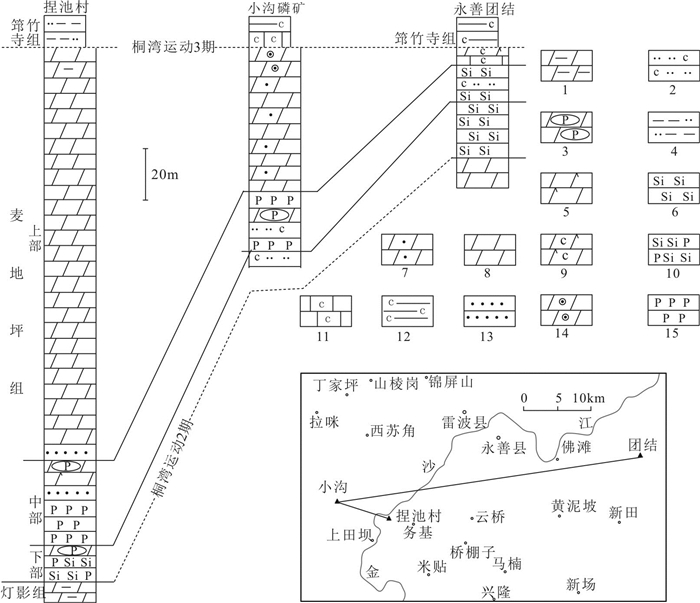
 下载:
下载:
